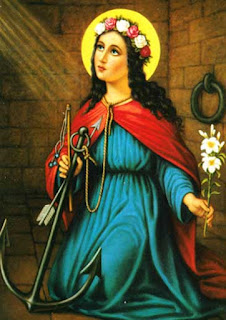The Cult of the Young Thaumaturgist - The Devotion to St. Philomena in the Philippines
 |
| St. Philomena of Masambong |
Though there were earlier shrines that were dedicated through her, it was only in the recent times that the devotion to this young miracle worker thrived over the years and fair enough, miracles were reported through her miraculous intervention. Almost every Catholic altars began to have an image of St. Philomena and pilgrimages to her shrines increased.
 |
| A popular depiction of St. Philomena |
The visage of the Thaumaturgist
The young Thaumaturgist (Miracle worker) is depicted as a beautiful young woman that are typically seen during the height of the Roman Empire. She has loose hair, wears a beautiful robe and sometimes, sports a crown of flowers for according to her apparition to a Dominican religious, she is a Grecian Princes.
She is depicted holding an anchor, rope, and arrows - symbols of her martyrdom ,a sheaf of lilies, a symbol of her purity and the diagnostic palm of martyrdom. The attributes of St. Philomena were based from the tiles in her tomb that are interpreted as symbols of her martyrdom.
 |
| A lithograph depicting the life of St. Philomena and the tomb tiles that were found in the Catacombs of St. Priscilla |
Little is known about the life of St. Philomena. However, it is believed she was a Greek princess who became a virgin martyr and died at 13-years-old. The remains of a young lady were discovered in May 1802 at the Catacombs of Priscilla on the Via Salaria Nova with three tiles reading "Pax Tecum Filumna" ("Peace be to you, Philomena.")
All that is known about St. Philomena's life comes from a Neapolitan nun's vision. Sister Maria Luisa di Gesu claims St. Philomena came to her and told her she was the daughter of a Greek king who converted to Christianity and was born in January 10. When Philomena was 13-years-old, she took a vow of consecrated virginity. After her father took his family to Rome to make peace, Emperor Diocletian fell in love with Philomena. When she refused to marry him, she was subjected to torture.
 |
| The Martyrdom of St. Philomena |
Devotion to St. Philomena began to spread once her bones were exhumed and miracles began to occur. Canon Francesco De Lucia of Mugnano del Cardinale received relics of St. Philomena and had them placed in the Church of Our Lady of Grace in Mugnano, Italy. Soon after her relics were enshrined, cancers were cured, wounds were healed and the Miracle of Mugnano, when Venerable Pauline Jaricot was cured of a severe heart issue overnight, were all attributed to St. Philomena. Other Saints began to venerate Philomena and attributing miracles in their lives to the young martyr, including St. John Marie Vianney and St. Peter Louis Marie Chanel.
 |
| Sta. Filomena de Alcala of Cagayan |
In the Philippines, the devotion to St. Philomena already began during the Spanish period, notably in Alcala, Cagayan where a Church was built in 1881 under the term of Fr. Casamiro Gonzalez, which was completed by Fr. Pedro Perez. the Shrine in Alcala, Cagayan became the center of the devotion to St. Philomena in the northern part of the Philippines.
In Sibonga, Cebu, the devotion to St. Philomena began in the Parish of Our Lady of the Pillar sometime between 1827 - 1830 when an image of her was enshrined in the church.
 |
| Sta. Filomena de Sibonga |
 |
| The National Pilgrim image of St. Philomena |
A pilgrim image that is known as the National Visiting Statue of St. Philomena that is enshrined in the National Center of the Living Rosary Association located in Mayon, Quezon City is making rounds to different schools, parishes and hospitals, communities and other institutions to propagate the devotion to St. Philomena to the other parts of the country.
The devotion to St. Philomena is very timely and relevant in the modern times for we are living in a world were immorality is very rampant in everywhere and being holy is now being ridiculed by the world. Let us ask the intervention of St. Philomena to help us in our spiritual battle that we face today.
We will end this blog entry dedicated to this Wonder Worker with the words of St. John Marie Vianney, one of the most ardent devotees of St. Philomena:
"My children, Saint Philomena has great power with God, and she has, moreover, a kind heart; let us pray to her with confidence. Her virginity and generosity in embracing her heroic martyrdom have rendered her so agreeable to God that He will never refuse her anything that she asks for us."
St. Philomena, pray for us!
References:
Castro, Alex (2016), "Sta. Filomena of Alcala, Cagayan", Retreived from http://andalltheangelsandsaints.blogspot.com/2016/11/271-sta-filomena-of-alcala-cagayan.html#comment-form.
Di Lucia, Francesco, Relazione istorica della translazione del corpo di S. Filomena vergine, e martire da Roma a Mugnano del Cardinale.
Hallack, Cecily, (1936), Saint Philomena : Virgin martyr and wonder worker. . Dublin, Ireland; Anthonian Press, 1936.
History of the Devotion to St. Philomena, Retrieved from http://saintphilomenaph.weebly.com/santuario-de-santa-philomena-manila.html.
Miravalle, Mark (2007), It Is Time to Meet St Philomena (Queenship Publishing Company, P. O. Box 220, Goleta, California 2007
The National Visiting Statue of St. Philomena An Apostolate of the Universal Living Rosary Association of St. Philomena, Philippines, Retreived from http://saintphilomenaph.weebly.com/the-visiting-statue-of-st-philomena.html.
Potestas, Clint Holton (2016), "Are you a believer?", Retreived from http://cebudailynews.inquirer.net/102153/are-you-a-believer.





Comments
Post a Comment